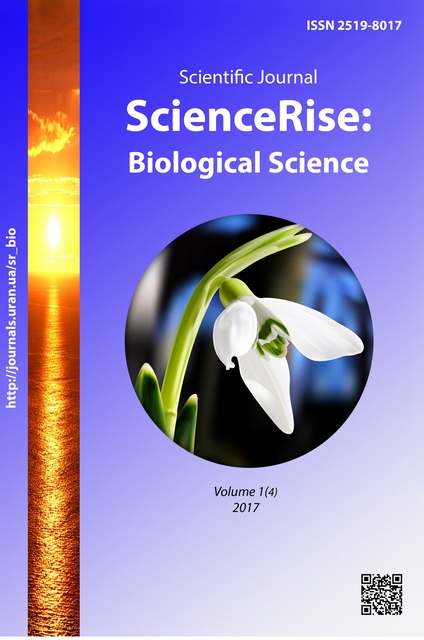The distribution of spinal evoked potentials across dorsal surface in conditions of dorsal roots transection
DOI:
https://doi.org/10.15587/2519-8025.2017.93617Keywords:
evoked potentials, amplitude, longitudinal distribution, deafferentation, dorsal root, spinal cordAbstract
The aim of experiments on the cats was determine specificity the distributions evoked potentials (EP) of the spinal cord (SС) across dorsal surface in lumbar segments before and after dorsal roots transection.
We used a standard electrophysiological techniques abduction biopotentials directly from the surface of the brain. To activate neurons SC was used stimulus on the nerves of the ipsilateral hindlimb.
In experiments was found that after transection one of the ipsilateral dorsal root (DR) observe a reduction of the first negative and positive component of EP and the displacement of the point of maximum response to centre of dorsal surface. Simultaneously with this, the second component increases in amplitude (the local process disinhibition of neurons of second component). The additional deafferentation brain near the investigated segment leads to oppression all the components of EP and shifts the point of maximum response on the contralateral side.
We conclude that a violation of the integrity of the dorsal roots after injury can be found depending on the amplitude of components of EP and the value of shift point of the maximum potential from the ipsilateral to contralateral part on the dorsal surface.
References
- Sabapathy, V., Tharion, G., Kumar, S. (2015). Cell Therapy Augments Functional Recovery Subsequent to Spinal Cord Injury under Experimental Conditions. Stem Cells International, 2015, 1–12. doi: 10.1155/2015/132172
- Qin, W., Bauman, W. A., Cardozo, C. (2010). Bone and muscle loss after spinal cord injury: organ interactions. Annals of the New York Academy of Sciences, 1211 (1), 66–84. doi: 10.1111/j.1749-6632.2010.05806.x
- Bazley, F. A., Hu, C., Maybhate, A., Pourmorteza, A., Pashai, N., Thakor, N. V. et. al. (2012). Electrophysiological evaluation of sensory and motor pathways after incomplete unilateral spinal cord contusion. Journal of Neurosurgery: Spine, 16 (4), 414–423. doi: 10.3171/2012.1.spine11684
- Regan, D., Regan, M. P. (2009). Evoked Potentials: Recording Methods. Encyclopedia of Neuroscience, 29–37. doi: 10.1016/b978-008045046-9.00317-x
- Shugurov, О. О. (2011). The evoked potentials of spinal cord under influence on him of mechanical stimulus. Visnyk of Dnipropetrovsk University. Biology. Medicine, 2, 125–129.
- Shugurov, О. А., Shugurov, O. O. (2006). Evoked potentials of spinal cord. Dnipropetrovsk: Sciense and Education, 319.
- Shugurov, O. O. (2016). The dorsal root damage identifications by the longitudal distribution of the evoked potentials of spinal cord. ScienceRise, 2 (1 (19)), 16–22. doi: 10.15587/2313-8416.2016.60275
- Quiroz-Gonzalez, S., Segura-Alegria, B., Guadarrama-Olmos, J. C., Jimenez-Estrada, I. (2014). Cord Dorsum Potentials Evoked by Electroacupuncture Applied to the Hind Limbs of Rats. Journal of Acupuncture and Meridian Studies, 7 (1), 25–32. doi: 10.1016/j.jams.2013.06.013
- Grunewald, B., Geis, C. (2014). Measuring spinal presynaptic inhibition in mice by dorsal root potential recording in vivo. Journal of Visualized Experiments, 85, e51473. doi: 10.3791/51473
- Carlton, S. M. (2014). Nociceptive primary afferents: they have a mind of their own. The Journal of Physiology, 592 (16), 3403–3411. doi: 10.1113/jphysiol.2013.269654
- Cote, M.-P., Detloff, M. R., Wade, R. E., Lemay, M. A., Houle, J. D. (2012). Plasticity in ascending long propriospinal and descending supraspinal pathways in chronic cervical spinal cord injured rats. Frontiers in Physiology, 3, 330. doi: 10.3389/fphys.2012.00330
- Wang, G., Scott, S. A. (2002). Development of “normal” dermatomes and somatotopic maps by “abnormal” populations of cutaneous neurons. Developmental Biology, 251 (2), 424–433. doi: 10.1006/dbio.2002.0824
- Laumonnerie, C., Tong, Y. G., Alstermark, H., Wilson, S. I. (2015). Commissural axonal corridors instruct neuronal migration in the mouse spinal cord. Nature Communications, 6, 7028. doi: 10.1038/ncomms8028
- Rudomin, P. (2009). In search of lost presynaptic inhibition. Experimental Brain Research, 196 (1), 139–151. doi: 10.1007/s00221-009-1758-9
Downloads
Published
How to Cite
Issue
Section
License
Copyright (c) 2017 Олег Олегович Шугуров

This work is licensed under a Creative Commons Attribution 4.0 International License.
Our journal abides by the Creative Commons CC BY copyright rights and permissions for open access journals.
Authors, who are published in this journal, agree to the following conditions:
1. The authors reserve the right to authorship of the work and pass the first publication right of this work to the journal under the terms of a Creative Commons CC BY, which allows others to freely distribute the published research with the obligatory reference to the authors of the original work and the first publication of the work in this journal.
2. The authors have the right to conclude separate supplement agreements that relate to non-exclusive work distribution in the form in which it has been published by the journal (for example, to upload the work to the online storage of the journal or publish it as part of a monograph), provided that the reference to the first publication of the work in this journal is included.









